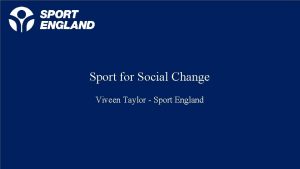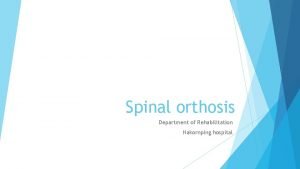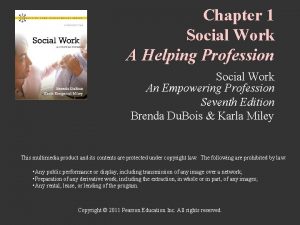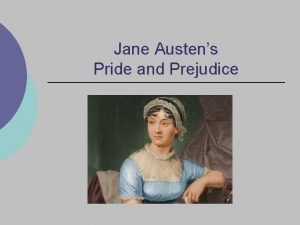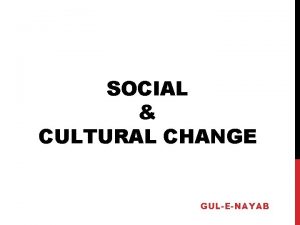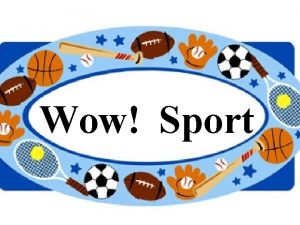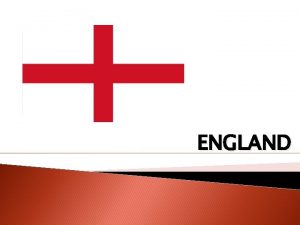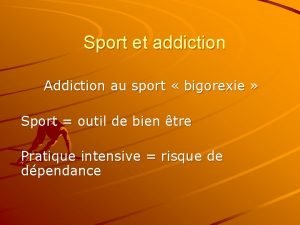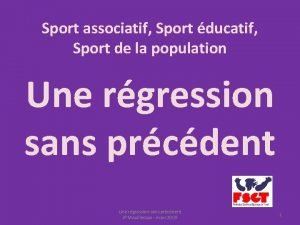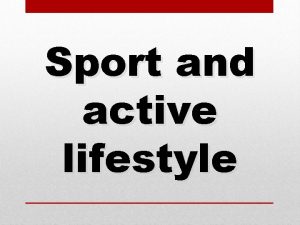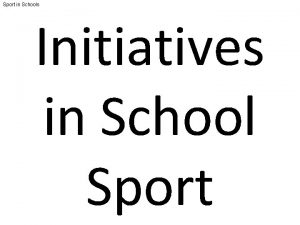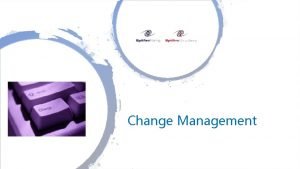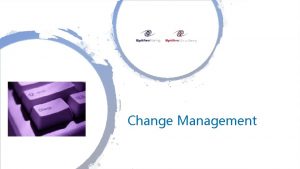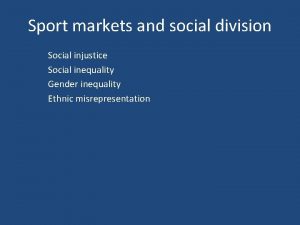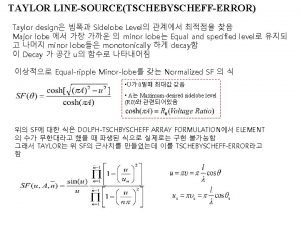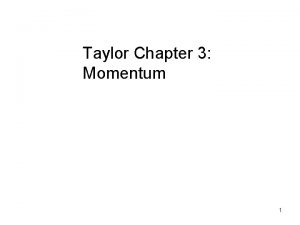Sport for Social Change Viveen Taylor Sport England
























- Slides: 24

Sport for Social Change Viveen Taylor - Sport England Creating a lifelong sporting habit

Agenda • Our current context • Reaching our priority audiences • Future direction Creating a lifelong sporting habit 2

CURRENT CONTEXT 3


OUR VISION We want everyone in England regardless of age, background or level of ability to feel able to engage in sport and physical activity. Some will be young, fit and talented, but most will be not. We need a sport sector that welcomes everyone – meets their needs, treats them as individuals and values them as customers. Sport England: Towards an Active Nation 2016 -21

The reasons why – ‘outcomes’ PHYSICAL WELLBEING Increase in population meeting the CMO guidelines for physical activity Decrease in population that are physically inactive MENTAL WELLBEING INDIVIDUAL DEVELOPMENT SOCIAL & COMMUNITY DEVELOMENT ECONOMIC DEVELOPMENT Improved subjective wellbeing Increased levels of perceived self-efficacy Increased levels of social trust Economic value of sport to the UK economy

A set of targets – population level change with a focus on those currently under-represented 28 m Active People - an increase of at least 500 k active people Increase of at least 250 k Women (nationally) Increase of at least 100 k Low SEG (in targeted places) Creating a lifelong sporting habit

levels of The scale of our challenge activity 11, 485, 300 Decrease inactivity - 11. 2 m who are doing little or nothing 5, 595, 000 27, 658, 700 Increase activity – there are 5. 4 m who are doing something but not enough to benefit as much as they could Support active people to stay active – our funding helps 28. 6 m people be active

THE OPPORTUNITIES OF A WHOLE SYSTEMS APPROACH TO TACKLING INACTIVITY

Supporting people to live active lives means we need to think about the ecosystem of influences Policy Physical environment Organisations and Institutions Social environment E. g. Local strategies, budgets, laws, rules, regulations, codes E. g. Built, natural, transport links E. g. Schools, GPs and health care, businesses, faith organisations, charities, clubs E. g. Individual relationships, families, support groups, social networks and norms Individual Source: Social-Ecological Model E. g. Individual capability, motivation, attitudes, beliefs, knowledge and behaviours Creating a lifelong sporting habit

We are learning important lessons as we go • • • Generating shared purpose is essential in creating systemic change Building a movement at all levels takes time but is essential There is often an empathy gap that needs overcoming Progress moves at the pace of trust Letting go and getting out of the way sometimes is the best thing Reaching inactive communities takes you beyond the “usual suspects” Demonstrating a different value is hard but essential – numbers vs outcomes You can’t take shortcuts in working through an ABCD approach Ripping up the rule book requires people at all levels to hold their nerve Creating a lifelong sporting habit 11

REACHING OUR PRIORITY AUDIENCES

Who are our priority audiences? • • Inactives Women (250, 000) LSEG (100, 000) BAME Disability including Long Term Conditions (#weareundefeatable) Older people Children Young People • LSEG – to date we have engaged 481, 562 and engagement numbers continue to grow Creating a lifelong sporting habit


Diversity within Low Socio Economic Groups • Low Socio Economic Group is not homogenous – it is a diverse group of communities and individuals (12 m people!) • We know there are inequalities within this group in comparison to other groups within the population from an economic, social and sport perspective • • People from lower socio-economic groups are diverse be it their age, gender, ethnicity or whether or not they have a limiting disability How best we can include communities in design and delivery of activity. • Our empathy and compassion is a key element of gaining that understanding

Confidential levels of activity socio-economic groups active Our data shows there are significant disparities between different socio-economic groups: • People who are in routine/semi-routine jobs and those who are long term unemployed or have never worked (NS-SEC 6 -8) are the most likely to be inactive (33%) and the least likely to be active (54%). This has not changed in the past 12 months. • People who are in managerial, administrative and professional occupations (NS-SEC 1 -2) are the least likely to be inactive (16%) and the most likely to be active (72%). inactive Note: NS-SEC classifications refer to ages 16 -65 only. Full details of what the NS-SEC categories mean can be found on the definitions page. 16

What it takes to create change at scale Case studies of major behaviour change programmes show us that real sustained change is hard and conversion rates are low Creating a lifelong sporting habit

Small Grants We’ve also changed our approach across 3 key areas: • We’ve provided clear guidance for projects that want to work with children age 5 -13 and projects that focus on football • We are also interested in activities that get people more physically active, including less formal activities and not just recognised sports • We’ve communicated more clearly our priority groups for Small Grants including LSEG, BAME, Children and Young People and inactive people Creating a lifelong sporting habit

Volunteering Priority • Increase the diversity of volunteers to better reflect society • Increase the number of people giving their time to sport & physical activity • Ensure volunteers have a meaningful experience and benefit from the outcomes of giving their time Creating a lifelong sporting habit

Active Partnerships • England-wide network of organisations who help us to meet our strategic priorities in a local context • 43 independent organisations – locally relevant • Significant capacity at a local level – c. 650 staff • ‘Enabling’ role – an independent ‘honest broker’ • Supporting (and often leading) development of opportunities based on a deep understanding of what people and places need • A maturing, collaborative relationship with Sport England that values our collective impact Creating a lifelong sporting habit

Active Partnerships ‘Primary Role’ Sport England investment to help meet the priorities of Towards an Active Nation based on local circumstances Through: • A strong granular understanding of the place and people • An ability to broker and facilitate a much wider range of relationships • Where necessary supporting projects and relationships on Sport England’s behalf • Supporting local authorities by consent Creating a lifelong sporting habit

TOWARDS THE FUTURE Creating a lifelong sporting habit

Strategy refresh – key phases and timeline Holding conversations - Sep 2019 to Jan 2020 Sharing the emerging big ideas - Jan 2020 to Mar 2020 Testing the emerging ideas - Mar 2020 to Sep 2020 Launching our finalised new strategy - Sep 2020 to Dec 2020 Creating a lifelong sporting habit

Viveen Taylor Viveen. Taylor@sportengland. org Creating a lifelong sporting habit
 Viveen taylor
Viveen taylor Jewett brace indication
Jewett brace indication Sport england market segmentation
Sport england market segmentation Social change in social work
Social change in social work Regency era social classes
Regency era social classes Middle colonies social structure
Middle colonies social structure Social thinking and social influence in psychology
Social thinking and social influence in psychology Social thinking social influence social relations
Social thinking social influence social relations Formuö
Formuö Typiska novell drag
Typiska novell drag Nationell inriktning för artificiell intelligens
Nationell inriktning för artificiell intelligens Returpilarna
Returpilarna Varför kallas perioden 1918-1939 för mellankrigstiden?
Varför kallas perioden 1918-1939 för mellankrigstiden? En lathund för arbete med kontinuitetshantering
En lathund för arbete med kontinuitetshantering Adressändring ideell förening
Adressändring ideell förening Vilotidsbok
Vilotidsbok A gastrica
A gastrica Vad är densitet
Vad är densitet Datorkunskap för nybörjare
Datorkunskap för nybörjare Tack för att ni lyssnade bild
Tack för att ni lyssnade bild Hur skriver man en debattartikel
Hur skriver man en debattartikel Magnetsjukhus
Magnetsjukhus Nyckelkompetenser för livslångt lärande
Nyckelkompetenser för livslångt lärande Påbyggnader för flakfordon
Påbyggnader för flakfordon Lufttryck formel
Lufttryck formel
